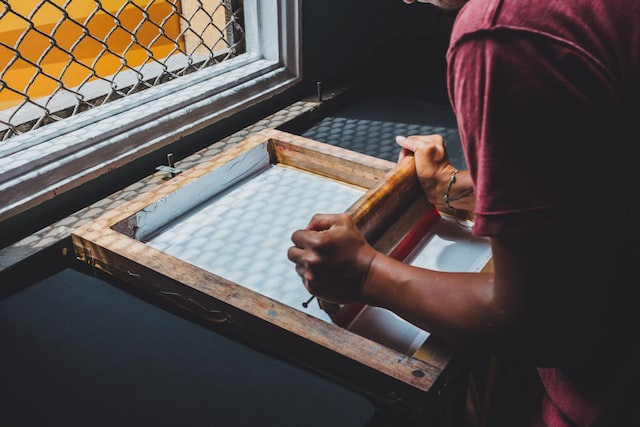The silk-screen process, also known as screen-printing, is a creative art form that allows you to transfer amazing designs onto custom t-shirts, bags, hats, and more. While many people enjoy silk screening items at home, this hobby can also turn into a profitable business venture. If you’re interested in learning how to turn your silk-screening hobby into a business, this guide can help you get started. From drafting a business plan to buying equipment and setting up a workspace, read on to learn how you can turn a fun hobby into a business at home.
Brainstorming a business plan
Before starting a small screen-printing business, you’ll need to develop a plan. Sit down and brainstorm a few ideas, so your vision and goals are clear and easier to reach. Here are some things to keep in mind:
- How much will your upfront costs be? How much will ongoing costs be? Upfront costs can include buying equipment, securing a work area, and obtaining inventory. Ongoing costs may include marketing, inks, and replenishing your inventory as you make more sales.
- Who’s your intended audience? Are you marketing to sports fans, music lovers, or trendy fashionistas? To be successful in business, you should always determine your niche target market before you start selling products.
- How much should clients pay? Determine what you plan to charge your customers for your silk-screened products. This usually depends on how much items cost you to source, how much time you spend making them, and the cost of other things like shipping.
- What will you name your company? Once you have a basic business plan laid out, think about what you want to name your new company. You can also ask friends and family members for their opinion and input. Write down several different ideas, then narrow it down to the one that appeals to you the most.
Incorporate your silk-screening company as a legal entity
To be a legitimate business, you’ll need to register your silk-screening company as a legal entity. First, confirm that your business name is unique and that no other companies have the same name. Now is also the time to decide whether you want to create an LLC, sole proprietor, or another business type.
Once you do this, you’ll need to register your business in your specific state. It’s also a good idea to check your website URL to confirm that it’s unique and available. You should also decide if you want to register your company for a federal trademark, but it’s not always a necessity, especially with a new business startup.
Register your silk-screening company with the IRS
Whether you’re silk screening as a corporation or a small home business, you’ll need to register with the IRS. This straightforward process can be done online and will ensure that you’re properly registered in the system for tax purposes.
You can get your federal Employer Identification Number (EIN) in one simple session by accessing your state’s website and entering the information in the state application. Once you’re done, it’ll take you to the same application on the IRS website. Some small businesses choose to use their social security number, which is usually fine if you’re not registering as an employer who will pay employees.
Obtain the required licenses and permits for your silk-screening business
Not every state has requirements for business licenses and permits, but it’s crucial that you check with your specific location to confirm. If your state and local laws require it, you may need to register for a business license and get a permit to do business in your city and your state.
Look into registering for a business license that lasts several years so you don’t have to remember to renew it every year. The fees for these licenses and permits will vary, so it’s best to check with your locality to confirm what your costs will be in advance.

Apply for a business credit card and open a business bank account
If you need some capital to get your business started, there are several options available to give you a financial boost. When you start a new business, it’s important to ensure you have enough money to obtain supplies, inventory, and cash for licensing and marketing. There are several ways to get the money you need:
- Apply for a business credit card so you can keep business-related expenses separate. Look for cards with special rewards like bonus points or cash-back to help you save.
- Now is the time to open a separate business bank account if you already have some money saved for your new venture. This helps with accounting since your money for the business will be separate from your personal income and expenditures. It’s also extremely helpful when you’re doing your business taxes; everything is together in one separate place as you track your profit and loss.
- Depending on how much money you need, you could be eligible for a small business loan. The Small Business Administration offers loans to businesses at low-interest rates. It’s worth looking into, especially if you need a decent amount of money up front to get your business started.
Get business insurance for silk-screening
If you’re getting a bank loan to get your business started, you may also need to purchase business insurance. Business income insurance covers you in case of property damage, while professional liability insurance protects you against lawsuits. Contact a business insurance broker or provider to find out which types of business insurance you may need for your new silk-screening company.
Getting started at home
When you start your silkscreen home business, you’ll need items like equipment and materials. If you already have silk-screening equipment, there are other items you may want to add before you market your company.
Buying silk-screening equipment
Here are the key silk-screening equipment items you’ll need:
- Conveyor dryer: These heavy-duty dryers are a must-have for silk-screening. They cure inks at a fast rate to help improve production times for businesses.
- Flash dryer: This small dryer is used to set the ink before printing another color on top of it, so the various colors don’t bleed into one another.
- Yellow light: If you silk-screen products with emulsion, you’ll need a yellow light to help you see while working in a darkroom.
- Tools: Don’t forget basic tools like T-squares, squeegees, rags, and ink, which are all part of the silk-screening process.
- Products: Are you going to be selling t-shirts? How about bags or hats? Make sure you have a wide range of products in assorted sizes and colors so you can take orders and ship items as soon as possible.
- Marketing: You’ll want to set aside money for your website and marketing to get your new business out to the masses.
Screen-print training
Some major manufacturers of screen-printing equipment offer free training to teach you how to use their products. Ask the retailer or manufacturer for more information before making a purchase.
You can also find a wide range of helpful screen-printing training classes online that may help you hone your skills or learn new techniques. If you just plunked down a lot of cash for expensive, heavy-duty, or high-tech equipment, then knowing how to use it correctly is vital. Look into training opportunities to ensure that you’re doing things in the best and most efficient way possible.
Workspace set-up
Look for places in your home that you can convert into a workspace for silk screen printing.
- A garage is a good starting place for working with screen printing. It has excellent ventilation, too.
- A spare bedroom can be a good space, but make sure there’s ample room for your equipment. A large family room may work better.
DIY
If you have a well-ventilated workspace, make sure it also has everything else you need. Ensure the area has enough outlets so it can handle all the equipment you need to plug in. You should also make sure the area has ample lighting so you can easily see what you’re doing. A space with a lot of windows and natural light is a smart choice.
Organize your new workspace so it’s easy to find everything you need. Add some floor or wall shelving and store items like small tools and screen-printing inks in boxes or bins. Label each container so you can quickly grab what you need.
Hiring a professional
Some of your heavier-duty equipment may have specific voltage requirements that need the attention of a licensed electrician or other professional. For example, conveyor dryers need a minimum voltage of 220v, so you might need to install a new outlet or breaker to keep your equipment running smoothly. If the room needs extra light, ask the electrician to install new light fixtures.
Aside from hiring an electrician, consider hiring a home improvement contractor to help you build add-ons like cabinets, work benches, or worktables for your new screen-printing production area.
Create a brand for your silk-screening business
After you’ve determined your target market, you’ll need to focus on branding your new business. Decide on a creative business name and logo, then come up with a tagline that’s easy for people to remember. Branding is the most important part of any business, as this is what customers will recognize and remember whenever they see your marketing or advertisements.
Spread the word about your brand through various marketing techniques, like your website and social media accounts. More information about these tactics is below. Ultimately, your new business’s brand defines you, so choose your name and logo carefully.

Make a website for your silk-screening business
Come up with a short, catchy URL (website name.com) for your silk-screening business. Make sure the website isn’t already registered, then have fun designing your new site.
You’ll need to pay for web hosting and if you’re not savvy in web design, consider paying a professional web designer to help you. Part of the website should include your online store with all of your designs, products, and pricing. Make sure the images are clear and crisp. You can also add content like a video about your company to introduce yourself to customers.
Opening social media accounts for your silk-screening business
Social media accounts on Facebook and Instagram are a great way to engage customers and spread the word about your business. You can also use Pinterest and Twitter to share photos and tweets with your followers.
If you set up a Facebook and Instagram account, be sure to post frequently to make your business more visible. Answer questions from customers as quickly as possible and work on active engagement. This is the best way to stay on top of the algorithm and to give customers a positive perception of your business.
Opening an account on Etsy or Shopify
Platforms like Etsy are excellent for selling handmade wares. If you’re looking for an easy way to get sales, consider using Etsy to sell your custom screen-printed tees, bags, and other items.
You can also look into opening a Shopify account. This is a great way to set up a business website through one single platform. Shopify will let you set your prices, showcase your inventory, and process payments all in one place. Check their online blog for excellent advice about running a business, helpful tutorials, and more. Both Etsy and Shopify are excellent companies to help you promote your business online.
Install a business phone system
You’ll need to have an official business phone number so customers can reach you. Consider setting up a separate business phone number or phone response/answering system so people aren’t calling your home number or personal cell phone. You can easily convert a WhatsApp Messenger account to a business account.
Introducing tie-dye
Many people who enjoy doing silk-screen as a hobby also enjoy making tie-dye t-shirts and other items. If you’re thinking about branching out and selling tie-dyed items, the process is fairly simple. Look into some tutorials to learn how to process tie-dyed products at scale. You can also make tie-dye items and add your own custom silk-screened graphics on them for an even more unique look. The tie-dye trend has grown in popularity recently, so it’s a smart way to get more sales when you start your business.

If you’ve been doing silk screening as a casual hobby and you’re ready to turn it into something more, remember these tips to help you start your home business. We can confidently say that starting a silk-screening business is considered to have a higher survival rate as a start-up since it is involved with manufacturing, this is according to a recent report released by HAH.
So, with a good business plan and a bit of legwork, you can start selling your talents to people all over the world. Remember to incorporate marketing tactics, create a beautiful website, and engage with your customers to help increase the outreach of your brand. The right equipment and great branding will ensure that your silk-screen business is a success.




